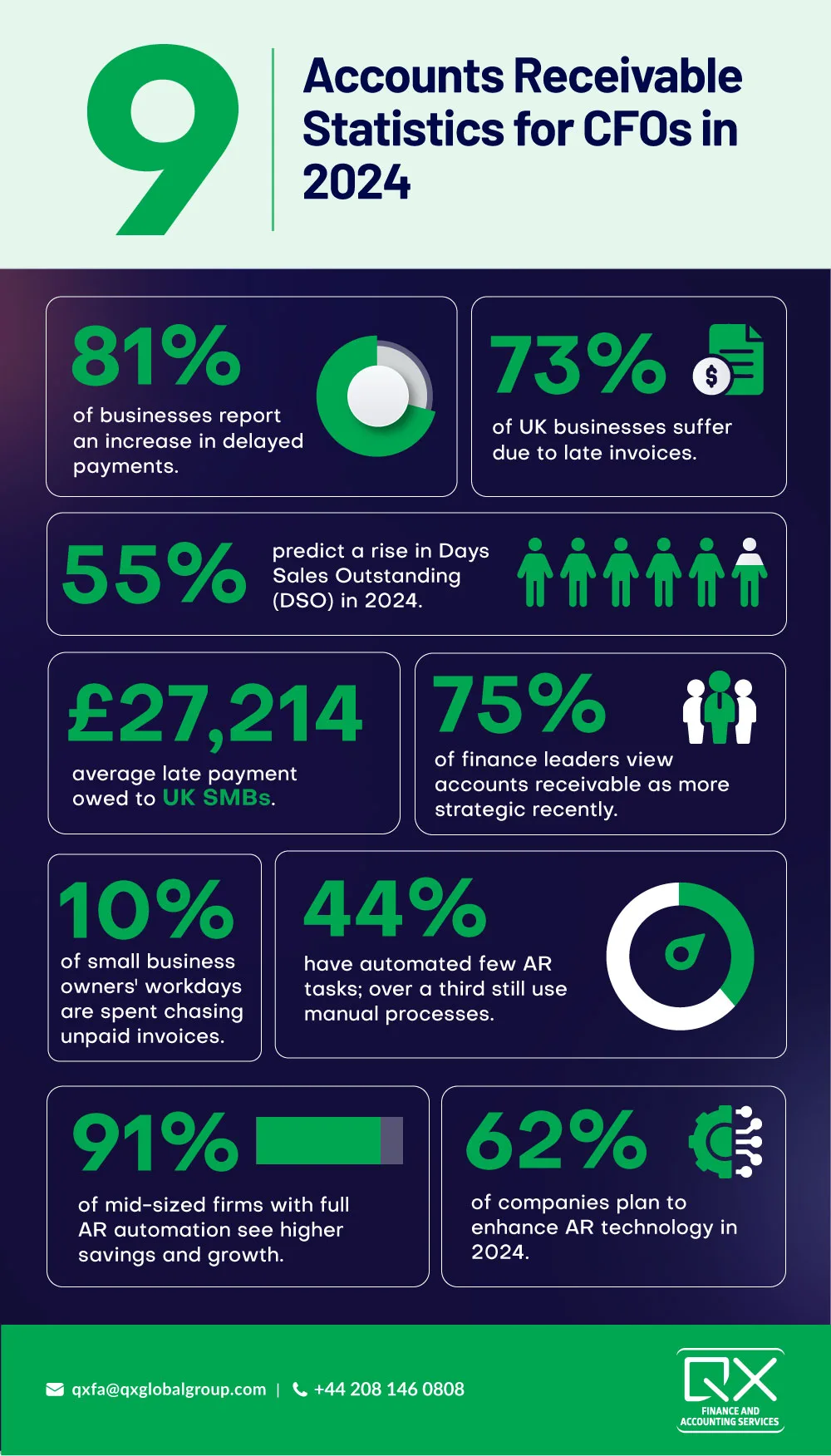Topics: Accounts Receivable Process, Finance and Accounting Outsourcing Services
Posted on August 30, 2024
Written By Priyanka Rout

Let’s begin with an insightful stat- According to a survey conducted by Intuit QuickBooks, 73% of UK businesses report experiencing adverse effects due to late invoice payments.
This is a major reason why many businesses today are thinking of accounts receivable outsourcing. Exploring the benefits of outsourced AR can significantly enhance your company’s financial efficiency by improving invoice accuracy and reducing the days sales outstanding. It isn’t just a financial strategy; it’s a move towards smarter, leaner operations. At its best, outsourcing can free up your team to focus on growth while enhancing cash flow and reducing overhead costs. But, like any strategic decision, it comes with its own set of challenges and considerations.

Outsourcing means placing an essential part of your business operations in the hands of accounts receivable outsourcing firm. This raises important questions about maintaining quality and control. How do you ensure your standards are met when your processes are handled externally? How do you build a communication strategy that keeps things transparent and efficient?
In this blog, we’re going to get into the nitty-gritty of outsourcing accounts receivable services. We’ll cover how to ensure you’re maintaining quality, the best ways to keep in touch with your outsourcing partner, and the strategies that make outsourcing work in your favor. The goal? To give you all the info you need to make this process work smoothly and benefit your business in the long run by improving cash flow management through outsourcing.
Quality in accounts receivable outsourcing isn’t just about sticking to industry standards—it’s about aligning with your unique business goals. According to a 2024 Revelwood survey, 75% of finance leaders indicate that accounts receivable has taken on a more strategic role over the past 12 to 24 months. By crafting custom quality metrics tailored to your specific needs, you can integrate outsourcing more seamlessly into your business strategies. As part of their strategies for better cash flow, CEOs and CFOs are increasingly focusing on streamlining operations and capital management to maintain a healthy balance sheet. This tailored approach doesn’t just measure performance; it enhances transparency and aligns services with your company’s core objectives.
According to a recent study by PYMNTS, 91% of mid-sized firms with fully automated accounts receivable systems have reported enhanced savings, improved cash flow, and increased growth. Imagine having a dashboard that updates you in real-time about every facet of your AR processes. That’s the power of real-time analytics. This tool allows you to keep a pulse on your operations, from tracking payment behaviors to spotting potential bottlenecks before they become issues. It’s not just about gathering data; it’s about using this information to make smart, timely decisions that keep your operations smooth and efficient.
Artificial Intelligence (AI) and Machine Learning (ML) are changing the game in AR by predicting payment behaviors and refining invoice management. These technologies do more than crunch numbers—they learn from patterns to make smart predictions about future payments and help prioritise tasks. For example, AI can automate mundane tasks, flag discrepancies, and provide insights that help tailor your approach to each customer.
Explore our latest blog on “Benchmarking Performance in AR Outsourcing: Metrics That Matter” and learn how to measure success effectively!
Think of a communication charter as your roadmap for collaboration. It’s where you lay out who does what, how often you’ll talk, and how you’ll handle any disagreements that come up. Key components include:
According to research by Wakefield and Versapay, 85% of C-level executives report that inadequate communication between their accounts receivable team and customers has resulted in nonpayment. To enhance communication with customers, it is crucial to establish a structured system within the internal team. Tools like Slack and Microsoft Teams are game changers for keeping communication fluid and transparent. Here’s how they can help:
Discover how QX ProAR revolutionised financial operations for UK healthcare recruiters.
As we all know, keeping up with the pace of change can be daunting, but it’s also packed with opportunities, especially when it comes to accounts receivable outsourcing services. By embracing new technologies like real-time analytics and AI, we’re not just speeding things up—we’re also gaining a clearer view of our finances. This allows us to make smarter decisions faster, which is crucial in today’s business environment.
Moreover, it’s time to rethink our old outsourcing habits. The traditional models are no longer enough. We need approaches that are as flexible and dynamic as the markets we operate in. This isn’t just about adapting; it’s about thriving, building stronger partnerships, and making sure our financial operations help us meet our business goals.
Predictive analytics can enhance the collections process in outsourced AR operations by identifying patterns in payment behaviors, allowing firms to prioritise and target high-risk accounts. This targeted approach improves the efficiency of collections efforts, reduces days sales outstanding (DSO), and enhances cash flow. Outsourcing accounts receivable services can adapt to market conditions or company needs by employing scalable resources and technologies. Providers can quickly adjust staffing levels, utilise advanced technologies, and implement strategic changes to manage fluctuations in workload, ensuring continuity and responsiveness to client needs. Real-time reporting tools in outsourced accounts receivable services provide immediate access to financial data, enabling better tracking of receivables performance. This timely information helps companies make informed decisions quickly, identify potential issues early, and adjust strategies to optimise cash flow and minimise credit risk. FAQs
How can predictive analytics specifically improve the collections process in outsourced AR operations?
How can AR outsourcing adapt to sudden shifts in market conditions or company needs?
How can real-time reporting tools in outsourced AR services enhance decision-making?
Originally published Aug 30, 2024 11:08:08, updated Jan 15 2025
Topics: Accounts Receivable Process, Finance and Accounting Outsourcing Services